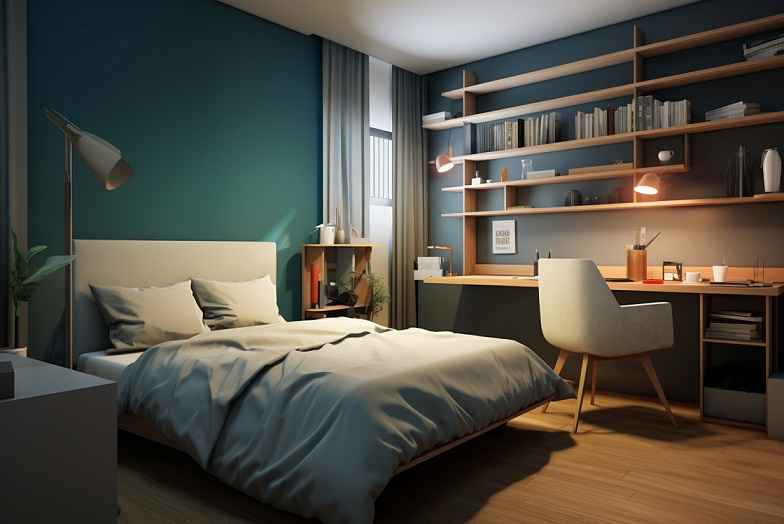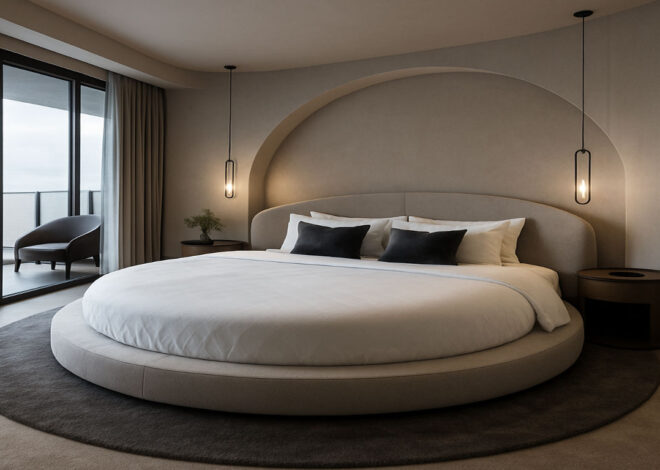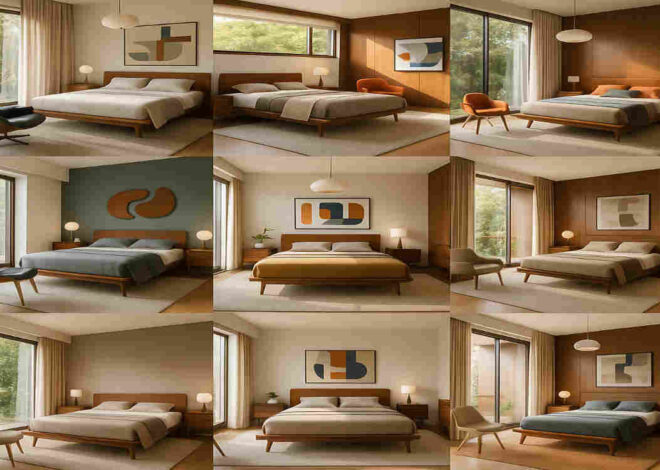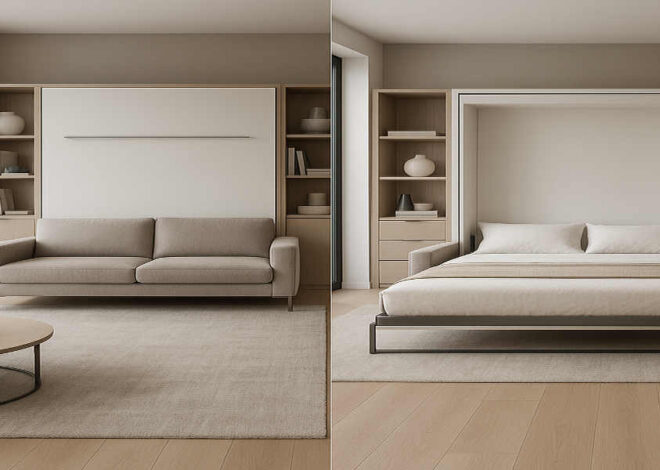
Home Away from Home: Essential Tips for Designing the Perfect Guest Room
Imagine this: a cozy retreat where your friends and family can unwind, recharge, and feel right at home—without the hassle of travel. A well-designed guest room is more than just an extra space; it’s an invitation to create lasting memories and strengthen bonds with those you love. Whether you’re hosting a weekend getaway or welcoming relatives for the holidays, transforming your spare room into a stylish sanctuary is easier than you think! In this blog post, we’ll explore essential tips that blend comfort with creativity, ensuring every guest feels cherished in their “home away from home.” Get ready to roll up your sleeves and make some magic happen in that empty room—it’s time to turn it into the ultimate haven for relaxation!
Introduction: Why a well-designed guest room is important
Creating a guest room is more than just providing a place for visitors to sleep. It’s about making them feel welcome, comfortable, and at home. A well-designed guest room can leave a lasting impression on friends and family, encouraging them to return again and again. Whether it’s for the occasional overnight stay or an extended visit, your guest space should reflect warmth and hospitality.
Imagine your guests stepping into a thoughtfully curated haven that feels both inviting and relaxing. With the right decor choices and layout considerations, you can turn any spare room into a cozy retreat tailored for comfort. Let’s explore some essential tips to help you design the perfect guest room—a true home away from home!
Step 1: Assess Your Space
Start by determining the purpose of your guest room. Will it be exclusively for visitors, or do you plan to use it for other activities as well? Knowing this will guide your design choices.
Next, take a good look at the size and layout. A small room may benefit from light colors and minimalist decor to create an illusion of space. If you have more room to work with, you can get creative with furniture arrangements.
Don’t forget to assess what’s already in the room. Take inventory of existing furniture and decor that could enhance your new vision. Consider how pieces can be repurposed or updated rather than replaced entirely—this is both cost-effective and environmentally friendly.
By carefully evaluating these factors, you’re laying a solid foundation for an inviting space tailored specifically for your guests’ comfort.
Step 2: Assess Your Space
Before you can begin designing the perfect guest room, it is important to thoroughly assess the space you have available. This will help you determine what furniture and accessories will fit in the room and how to best utilize the space.
The first step in assessing your space is to measure the room. Use a measuring tape to get accurate dimensions of the length and width of the room. It is also helpful to measure any alcoves, windows, or doors that may affect furniture placement. Be sure to note any architectural features such as built-in shelves or wall niches.
Once you have measured the room, consider its layout. Think about how guests will enter and move around in the space. If there are any obstacles such as a radiator or low ceiling, take these into account when planning your design.
Next, evaluate the lighting in the room. Natural light is always ideal for a guest room, so try to incorporate it if possible. Consider adding curtains or blinds that can be opened during the day but provide privacy at night. If natural light is limited, make sure there are enough lamps or overhead lights for guests to use.
Another important aspect of assessing your space is considering storage options. Guests will appreciate having a place to store their belongings during their stay. Evaluate whether there is enough closet or drawer space in the room for guests to unpack their clothes and keep them organized.
In addition to storage for clothing, think about other necessities that guests may need during their stay such as extra blankets, towels, and toiletries. Make sure these items can easily be accessed by providing an extra dresser or shelving unit.
Take into account any potential noise factors in the guest room’s location within your home. Is it close to a noisy street? Is it next door to a shared bathroom? These factors may influence where you place certain pieces of furniture and décor items.
By carefully assessing your space before beginning the design process, you can ensure that your guest room will be functional and comfortable for your guests. Taking the time to measure, evaluate layout and lighting, consider storage options, and account for noise factors will help you create a welcoming space that your guests will appreciate during their stay.
-
Determine the purpose of the room (guests only or multi-functional)
Understanding the purpose of your guest room is crucial. Will it serve solely as a retreat for visitors, or will it pull double duty?
If it’s just for guests, focus on creating a serene and inviting atmosphere. Soft colors and cozy furnishings can make all the difference. Think about what amenities might enhance their stay.
However, if you envision the space being multi-functional, consider how to adapt it easily. A fold-out sofa bed works well in smaller areas while providing extra seating during gatherings.
Storage solutions become vital in this scenario. Look for stylish baskets or bins that keep essentials organized without cluttering the aesthetic.
Ultimately, tailoring your design to its intended use ensures both comfort and practicality. This thoughtful approach lays a solid foundation for any guest room decor choices you’ll make next.
-
Consider the size and layout of the room
When designing your guest room, size and layout are crucial. A spacious area allows for more flexibility in furniture arrangements, while a smaller space requires thoughtful planning to maximize comfort.
Start by measuring the dimensions. Knowing the square footage helps you choose appropriately sized furniture. Oversized pieces can overwhelm a compact roomhttps://comeawayhome.co.uk/space-saving-solutions-best-furniture-compact-rooms/, making it feel cramped.
Consider traffic flow as well. Ensure there’s enough space for guests to move around easily without bumping into furniture or each other. Placing a bed against the wall can free up walking paths and create an inviting atmosphere.
Think about natural light too. Positioning beds near windows not only enhances the ambiance but also gives guests a cozy spot to relax with morning sunlight streaming in.
Ultimately, understanding what you have will guide your design choices effectively and create a welcoming retreat for visitors.
-
Take inventory of existing furniture and decor
Before diving into the design process, it’s crucial to assess what you already have. This inventory can save time and money while guiding your decisions.
Walk through your space with a critical eye. What furniture pieces are worth keeping? A comfy chair or an antique dresser could add character to the room.
Next, consider decor elements that might work well in a guest room setting. Wall art, lamps, or even throw pillows can transform an ordinary space into something special.
Don’t forget about functionality—think about how each piece will serve your guests’ needs. A bedside table with storage can be both practical and stylish.
By evaluating existing items thoughtfully, you’ll create a cohesive look while ensuring comfort for those who stay in your home.
When designing a guest room, it’s important to take inventory of the existing furniture and decor that you have available. This will not only save you money, but it can also help guide your design decisions and ensure a cohesive look in the room.
The first step is to go through any furniture that is currently in the room. Take note of what pieces can be used for the guest room and which ones should be removed or replaced. For example, if there is a large dresser taking up too much space, consider replacing it with a smaller one to make more room for other essential items such as a nightstand or luggage rack.
Next, take an inventory of any decor items in the room. Are there any paintings or wall hangings that could fit into your desired theme for the guest room? Perhaps there are some extra throw pillows, blankets or curtains that can add some color and coziness to the space.
Once you have taken stock of what’s available, it’s time to assess what else you may need for the guest room. Consider practical items such as extra bedding and towels, as well as decorative pieces like vases, candles or picture frames. Keep in mind that these items don’t have to be expensive – thrift stores and discount home decor stores can offer great options at affordable prices.
If you find yourself lacking certain furniture pieces or decor items after taking inventory, don’t worry – this is where creativity comes in! Look around your home for unused items that could serve dual purposes in the guest room. For example, an old wooden ladder could be repurposed as a towel rack or a stack of vintage suitcases could act as both storage and decoration.
Another tip when taking inventory is to consider multi-functional furniture. A sleeper sofa can provide both seating and sleeping space for guests without taking up too much extra space in the room. A storage ottoman can serve as both seating and storage for extra blankets or pillows.
Taking inventory of existing furniture and decor not only helps with the design process, but it also allows you to repurpose items and save money. This step is essential in creating a guest room that is both functional and aesthetically pleasing. With careful planning and a bit of creativity, you can transform any spare room into a welcoming home away from home for your guests.
Step 3: Choose a Theme or Style
Choosing the right theme or style for your guest room can transform it into a welcoming retreat. Consider what ambiance you want to create. Cozy cottages, sleek modern designs, or beach-inspired aesthetics all offer unique vibes.
For a warm and inviting look, opt for soft colors and layered textures. Think about plush throws and decorative pillows that invite guests to unwind. A rustic charm can be achieved with wooden accents and vintage decor pieces.
If you’re leaning toward modern minimalism, keep things simple. Choose furniture with clean lines and neutral tones that promote calmness. Add just a few art pieces to maintain visual interest without overwhelming the space.
Don’t forget personal touches! Incorporate local artwork or family photos subtly so they enhance rather than dominate the atmosphere of your guest room décor. It’s all about balance—creating an inviting space while reflecting your style as well.
-
Discuss different themes/styles that work well for a guest room (e.g. cozy, modern, beachy)
Creating the perfect guest room often starts with selecting a theme that resonates. A cozy retreat can instantly make your guests feel at home. Think warm colors, plush textiles, and ambient lighting to create an inviting environment.
If modern aesthetics are more your style, go for sleek lines and minimalist decor. Opt for neutral palettes paired with bold accents. This creates a chic space that makes visitors feel both relaxed and inspired.
For those who love the ocean breeze, a beachy theme works wonders. Light blues, sandy beiges, and nautical decor invite tranquility. Incorporate natural elements like driftwood or seashells to enhance the coastal vibe.
Whichever style you choose, ensure it reflects comfort while showcasing your unique flair. Personal touches in art or decor will speak volumes without overwhelming the space.
When designing a guest room, it’s important to consider the theme or style that you want to convey. This will not only tie the room together but also make your guests feel more comfortable and at home. In this section, we will discuss different themes and styles that work well for a guest room, including cozy, modern, and beachy.
- Cozy: A cozy guest room is all about creating a warm and inviting atmosphere for your guests. To achieve this look, use soft and plush materials such as throw blankets, fluffy pillows, and comfortable bedding. Choose warm colors like shades of beige, cream, or earthy tones to create a sense of warmth in the space. You can also incorporate natural elements such as wooden furniture or woven rugs to add texture and coziness to the room.
- Modern: For those who prefer a more sleek and contemporary look for their guest room, a modern style may be the way to go. This style is characterized by clean lines, minimalistic furniture pieces, and neutral color palettes with pops of bold colors. Opt for simple yet stylish furniture pieces like platform beds or geometric-shaped nightstands. Add interest with abstract art pieces or statement lighting fixtures. Keep clutter to a minimum by utilizing storage solutions like built-in shelves or under-bed storage.
- Beachy: If you live near the coast or simply love the beach aesthetic, then a beachy themed guest room might be perfect for you. Incorporate elements from nature such as seashells, driftwood accents or coral-inspired decor pieces into your design scheme. Choose light and airy colors like white or light blue for walls and bedding to mimic the feeling of being at the beach. Complete the look with nautical touches like striped patterns on pillows or curtains.
No matter what theme or style you choose for your guest room, there are some key elements that should always be included to make it welcoming for your guests:
- Comfortable bedding: Ensure that your guests have a comfortable and cozy place to rest by investing in quality bedding. This includes soft sheets, extra blankets, and pillows.
- Adequate lighting: Make sure the room has enough light sources for your guests to read or work comfortably. A combination of overhead lighting, task lighting, and bedside lamps is ideal.
- Storage space: Your guests will appreciate having some space to unpack and store their belongings during their stay. Consider providing a dresser or closet with hangers for this purpose.
- Personal touches: Add personal touches like a welcome basket with snacks and toiletries, fresh flowers on the nightstand, or a framed photo on the wall to make your guest room feel more inviting and homey.
Choosing the right theme or style for your guest room is essential in creating a welcoming and comfortable space for your guests. Whether you opt for a cozy, modern, or beachy look, be sure to incorporate these key elements to make it feel like a true “home away from home” for your visitors.
-
Tips for incorporating personal touches without going overboard
Creating a personal touch in your guest room can make visitors feel at home. Start with art pieces that reflect your personality or local culture. A framed photograph of a scenic spot nearby can evoke warmth and connection.
Consider adding decorative cushions or throws that showcase your favorite colors. This subtle detail adds comfort while maintaining style.
Bookshelves filled with curated reads offer guests entertainment and insight into your interests. Opt for titles that spark conversation, inviting them to explore when they settle in.
Use scents to create an inviting atmosphere. Candles or diffusers with gentle fragrances like lavender or citrus set a relaxing tone without overwhelming the senses.
Lastly, leave a handwritten note welcoming guests, sharing Wi-Fi details, and recommending local spots to visit. These thoughtful gestures go a long way in making their stay memorable while keeping the decor balanced and not cluttered.
Step 4: Make it Comfortable and Functional
Creating a comfortable and functional guest room is vital for making visitors feel at home. Start with quality bedding; soft sheets and plush pillows can make all the difference in ensuring a good night’s sleep.
Consider adding storage options, like nightstands or dressers, where guests can stow their belongings. A luggage rack can also be handy, keeping suitcases off the floor and organized.
Incorporating thoughtful amenities adds an extra layer of comfort. Provide essentials such as towels, toiletries, and even a small welcome basket with snacks or drinks.
Lighting plays a crucial role too. Use bedside lamps for reading and consider blackout curtains to help guests rest undisturbed.
Lastly, think about flexibility. A fold-out sofa or an adjustable desk space can transform your guest room into more than just sleeping quarters—ideal for work or leisure during their stay.
You may also read (embrace charm vintage furniture home)
Step 5: Make it Comfortable and Functional
Once you have created a welcoming and inviting ambience in your guest room, the next step is to focus on making it comfortable and functional. After all, your guests will be spending most of their time in this space, so it’s important to ensure that they feel at ease and have everything they need for a comfortable stay.
-
Invest in Quality Bedding
The most important element of any guest room is the bed. Your guests should have a good night’s sleep, so investing in high-quality bedding is essential. Opt for soft and comfortable sheets with a high thread count, plush pillows, and a cozy comforter or duvet. Consider providing both firm and soft pillows to cater to different preferences.
-
Provide Extra Amenities
To make your guests feel pampered and well-taken care of, consider adding some extra amenities in the room. This could include a basket filled with toiletries such as toothbrushes, toothpaste, shampoo, conditioner, body wash, and lotion. You can also provide fresh towels, robes, slippers, and even a hairdryer for added convenience.
-
Create Storage Space
Make sure your guest room has enough storage space for your guests to keep their belongings organized during their stay. A closet or dresser with hangers is ideal for hanging clothes while shelves or drawers can be used for folded items. You can also add hooks behind the door or on the wall for additional hanging space.
-
Don’t Forget Lighting
Lighting plays an important role in creating a comfortable atmosphere in any room. Ensure that there are multiple light sources available such as table lamps on bedside tables or floor lamps near seating areas. If possible, install dimmer switches so that your guests can adjust the lighting according to their preference.
5. Don’t Skimp on Seating
Adequate seating is another crucial aspect of designing a functional guest room. Your guests should have a comfortable place to sit and relax, whether it’s for reading, working, or just unwinding. A cozy armchair or loveseat can be the perfect addition to your guest room, providing a separate space for your guests to retreat to.
6. Provide Refreshments
Having refreshments readily available in the guest room is a thoughtful gesture that will make your guests feel extra special. Consider setting up a coffee station with a coffeemaker, mugs, and supplies such as sugar and creamer. You can also provide bottled water and some snacks for those late-night cravings.
By following these tips, you can create a comfortable and functional guest room that will make your visitors feel right at home. Remember to pay attention to details and personalize the space according to your guests’ needs. A well-designed guest room is not only welcoming but also reflects on how much you value their stay in your home.
-
Essential items to include (e.g. comfortable bedding, storage for guests’ belongings)
Creating a welcoming guest room requires attention to key essentials. Start with comfortable bedding that invites relaxation. Invest in quality sheets, fluffy pillows, and a cozy duvet or blanket. A good night’s sleep is paramount for your guests’ experience.
Storage options are equally important. Provide adequate space for guests to unpack and feel at home. Consider adding a dresser or elegant shelving where they can stow away their belongings neatly.
A bedside table equipped with charging stations adds convenience and modernity. Guests appreciate having easy access to their devices overnight without searching through bags.
Small touches matter too—include extra blankets, towels, and toiletries within reach. Thoughtful details show you care about their comfort and need for privacy while staying in your home.
-
Ideas for making the space multi-functional (e.g.
When designing a guest room, it is important to consider how the space can serve multiple purposes. This not only maximizes its functionality but also allows for flexibility in its usage. Here are some creative ideas for making your guest room a multi-functional space:
- Add a Daybed or Futon If you have limited space, a daybed or futon can be an excellent addition to your guest room. During the day, it can function as a comfortable seating area for reading or working, and at night it can easily transform into an extra bed for guests.
- Install a Murphy Bed Another great option for small spaces is a Murphy bed. This is a bed that folds up against the wall when not in use, freeing up floor space and creating more room for other activities such as yoga or meditation.
- Create a Home Office Area In today’s digital age, many people work remotely or need a designated space for studying and productivity. Consider incorporating a desk and chair into your guest room design to create an efficient home office area.
- Utilize Built-in Storage Solutions Clutter can make any space feel cramped and unwelcoming, especially in a guest room where guests may want to unpack their belongings during their stay. Invest in built-in storage solutions such as shelves, cabinets, or drawers to keep the room organized and free of clutter.
- Make Use of Vertical Space When working with limited square footage, it’s essential to think vertically as well as horizontally. Consider hanging shelves near the ceiling or installing floating shelves above dressers to make use of unused vertical space.
- Incorporate Dual-Purpose Furniture Opting for furniture pieces that serve dual purposes is an excellent way to save on both money and space in your guest room design. For example, using an ottoman with hidden storage instead of just a regular coffee table provides both a place to sit and extra storage space.
- Designate a Reading Nook A cozy reading nook is a perfect way to utilize an empty corner of the guest room. Add a comfortable chair, a lamp, and some bookshelves to create an inviting spot for guests to relax and unwind.
- Use Versatile Lighting Lighting plays a crucial role in any room’s design, and incorporating multiple forms of lighting can make your guest room more versatile. A combination of overhead lighting, task lighting, and accent lighting can create different moods and serve various functions within the same space.
By implementing these ideas for making your guest room multi-functional, you can create a welcoming space that not only accommodates your guests but also serves as a useful area in your home when not in use. With proper planning and creativity, even the smallest guest rooms can become highly functional spaces with endless possibilities.
You may also read (long term advantages choosing sustainable furniture)


